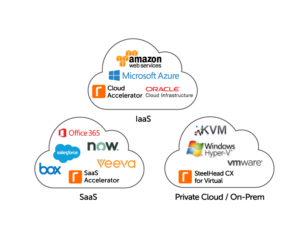It’s well established by now that businesses are looking to the cloud to help secure sustainable advantages over competitors. But in today’s digital world, technical and business leaders encounter several app migration challenges when moving enterprise workloads to a cloud environment.
An IT team’s ability to quickly deliver value to the business through the cloud is contingent on successfully navigating the architectural complexities imposed by the cloud era. Read on to explore some of the most common pitfalls organizations encounter when migrating apps to the cloud, and review our recommendations to avoid falling into the same traps.
Pitfall #1: Having an incomplete or outdated view of the infrastructure
Migrating an on-premises application to the cloud is a complex process. Most modern applications consist of multiple tiers and hundreds of microservices, make calls to multiple databases, and may consist of components from several third parties.
Thoroughly understanding the current application’s critical, hidden dependencies is a must. Otherwise, performance issues that impact the application or any of the associated services will almost certainly pop up. Unfortunately, many IT organizations lack an up-to-date view of their application architectures—often the result of sprawling islands of infrastructure and components that are constantly added, removed, or modified without clear documentation.
How to avoid this pitfall:
– Follow the best practices you followed during your data center consolidation efforts and apply them to your cloud migration project.
– Leverage NPM flow monitoring software to streamline the planning phase, quickly get a complete, accurate view of your application landscape, and validate how app components communicate before starting the migration.
Pitfall #2: Network bandwidth and latency constraints aren’t known or understood
Moving an application to the cloud significantly impacts two performance constraints: bandwidth and latency.
During and after the migration, bandwidth utilization increases and network links often become oversaturated, which can degrade the end-user experience. While the knee-jerk reaction here may be to buy more bandwidth, bigger pipes don’t solve the inherent limitations of physics.
Secondly, in traditional network architectures, where the traffic is backhauled through a corporate data center for security or SLA reasons, cloud-based applications end up traveling a longer distance to reach users when compared to their on-premises equivalents. That means the time it takes to complete a transaction could drastically increase, due to the increase in latency.
As you can imagine, not understanding the impact on these two constraints before the migration takes place could leave you with disastrous results and poor end-user satisfaction.
How to avoid this pitfall:
– Start with a cloud app migration assessment to visualize and quantify these end-to-end constraints by testing critical application transactions. You can use what-if analysis tools to pinpoint where excessive time and bandwidth are being consumed within the infrastructure and identify areas for improvement.
– Consider Application Acceleration solutions as an alternative to buying more bandwidth, which can reduce network utilization, accelerate applications, and increase transaction throughput.
– Look for opportunities to take certain cloud-destined traffic direct to the Internet and eliminate additional hops between your users and the cloud.
Pitfall #3: Application, network, and security teams continue to operate in silos
All too often, separate IT teams only focus on their specific domains. But remember that cloud computing is driving many considerations for overhauling the enterprise architecture and, therefore, responsibilities become a blended effort. For example, consider troubleshooting and monitoring duties, where the network team may be tasked with detecting and fixing an issue, even if the problem stems from a SaaS application.
As a result, war room scenarios become more complex and include more teams from more locations responsible for different IT functions. So, when it comes to ensuring cloud migration success, bridging IT silos is crucial.
How to avoid this pitfall:
– Develop a cross-functional task force and take what’s been successful in DevOps with regard to collaboration, agility, and instilling a culture of efficient responsibility and apply it to the cloud migration process.
– Create a centralized, dynamic view of the application’s performance to give operational teams a single source of truth, accelerating troubleshooting and providing meaningful data for stakeholders throughout the enterprise.
Learn more to ensure successful migrations and superior user experiences
